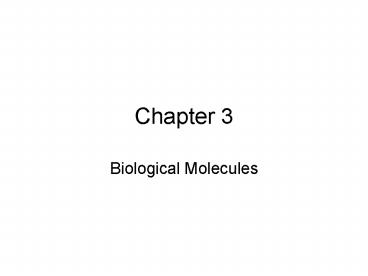Biological Molecules - PowerPoint PPT Presentation
1 / 45
Title:
Biological Molecules
Description:
Relatively large combinations of atoms of these elements ... Octane. Methane Molecule. Carbon bonds. Carbon-Carbon bonds release a lot of energy when broken ... – PowerPoint PPT presentation
Number of Views:27
Avg rating:3.0/5.0
Title: Biological Molecules
1
Chapter 3
- Biological Molecules
2
Life is built from select elements
- Most abundant
- Carbon
- Hydrogen
- Oxygen
- Nitrogen
- Calcium
- Phosphorus
- Less prominent, but still critical
- Sodium
- Potassium
- Iron
- Chlorine
- Magnesium
3
Biological Molecules
- Relatively large combinations of atoms of these
elements - Many are necessary for life because the breaking
and forming of new bonds provides energy - Molecular building blocks
4
Carbon
- Biological molecules are built around carbon (C)
- Important because it has four valence electrons
- Can form up to four single bonds with other
elements/molecules
5
Terms associated with Carbon
- Hydrocarbon
- A molecule whereby carbon is bonded ONLY with
hydrogen atoms - Examples include
- Methane
- Butane
- Octane
6
Methane Molecule
7
Carbon bonds
- Carbon-Carbon bonds release a lot of energy when
broken - Molecules made of carbon and hydrogen burn easily
at room temperature
8
Functional Groups
- Required to know
- Hydroxyl
- Carboxyls
- Phosphates
- Amino groups
- All of these groups are POLAR, although the
degree of polarity varies - Any of these may be prominent features of organic
compounds
9
Hydroxyl
- Comprised only of oxygen and hydrogen
- Polar, so it is likely to attach to a polar
region on molecules - Cause molecules to form hydrogen bonds, and may
dissolve completely in water
10
Carboxyl
- Composed of carbon, oxygen, and hydrogen
- Polar, quickly gives up the hydrogen (becomes an
ion) and makes the solution acidic - Molecules with this group also called carboxylic
acids
11
Phosphate
- The only functional group with phosphorus
- ANY of the four oxygens can bond with carbon
- Important in ATP (adenosine triphosphate)
12
Adenosine triphosphate (ATP)
13
Amino groups
- Composed of nitrogen and hydrogen
- NH3 is an intense gas and an effective cleaner
for removing bacteria - Amino groups do NOT make a molecule toxic after
forming bonds
14
REVIEW Functional Groups
- Hydroxyls
- Carboxyls
- Phosphates
- Amino groups
15
Four Kinds of Biological Molecules
- Lipids
- Carbohydrates
- Nucleic Acids
- Proteins
16
Lipids
- Important in the structure and formation of cell
membranes - Not water-soluble
- Commonly known as fats in dietary terms and in
food labels - Some of the most important lipids are
phospholipids and triglycerides
17
Lipids
- Carbon, oxygen, hydrogen
- Fats, oils, waxes, steroids, cholesterol
- Used for energy cell membrane structure
- Some hormones the myelin sheath around nerves
- Monomers for fats and oils fatty acids
glycerol
18
Fats and oils are triglycerides or
triacylglycerols.
19
To understand lipids
- we need to know a few more molecular structures
- These structures combine with hydrocarbon chains
in various ways, such that one end is polar. - Despite this polarity, remember that lipids are
not soluble in water
20
Glycerol
OH OH OH
H C C C H
21
Carboxyl Group
- COOH
Hydrocarbon Chain
22
Triglycerides
- Formed by THREE fatty acid molecules and a
glycerol molecule - Triglycerides are the main storage molecules for
lipids in the fat cells of animals
23
Dehydration Synthesis
3 fatty acids glycerol
fat/oil 3 H2O
triglyceride
24
Types of Fats
- Fats are important sources of energy for
organisms - Too many fats can create problems
- Two main types
- Saturated
- Unsaturated
25
A saturated fatty acid
H H H H H H H H H
H C C C C C C C C C
H H H H H H H H H
Carboxyl group
Hydrocarbon chain
A monounsaturated fatty acid
26
(No Transcript)
27
Carbohydrates
- Contain only carbon, hydrogen, and oxygen
- Examples sugars, starch, cellulose, glycogen,
chitin
28
Uses of carbohydrates in living things
- Supply energy
- Building materials in plant cell walls
invertebrate exoskeletons.
29
Terms with Carbohydrates
- saccharide- means sugar
- Monosaccharide
- ONE carbohydrate unit (subunit)
- Disaccharide
- TWO monosaccharides
- Polysaccharide
- TWO or more monosaccharides
30
Fig. 3.5a
31
Simple sugars are called monosaccharides.
- Glucose, fructose, and galactose are
monosaccharides.
isomers
32
Common Names
- Glucose blood sugar
- Fructose fruit sugar
- Sucrose table sugar
- Maltose malt sugar
- Lactose milk sugar
33
Figure 3.5b
34
(No Transcript)
35
Condensation or Dehydration Synthesis
- Unites 2 monomers
- By the removal of water
- Monosaccharide monosaccharide disaccharide
water
Glycosidic bond in disaccharide
36
Dehydration Synthesis
- Glucose Fructose ? Sucrose Water
37
Beta glucose
38
Dehydration Synthesis of glucose
glucose maltose water
39
Dehydration Synthesis of glucose
glucose maltose water
H2O removed dehydration
40
H
H
C
H
HO
C
H
HO
C
O
C
O
OH
H
H
H
H
H
C
C
C
C
H
OH
H
OH
H
HO
C
C
O
C
C
H
OH
H
OH
Glycosidic bond
41
Glucose
Glucose
H
O
Maltose
Water
42
Hydrolysis
Glucose
Glucose
H
O
Maltose
Water
43
Hydrolysis
- Digestion is an example of hydrolysis.
- Hydrolysis water breaking apart
- Hydrolysis requires 1 molecule of water for every
2 monomers broken apart.
44
Long chains of monosaccharides form
polysaccharides.
- Common glucose polymers are starch, glycogen,
cellulose, chitin, and pectin.
45
Four Kinds of Biological Molecules
- Lipids
- Carbohydrates
- Proteins
- Amino groups/amino acids
For next week Also, read Chapter 4































